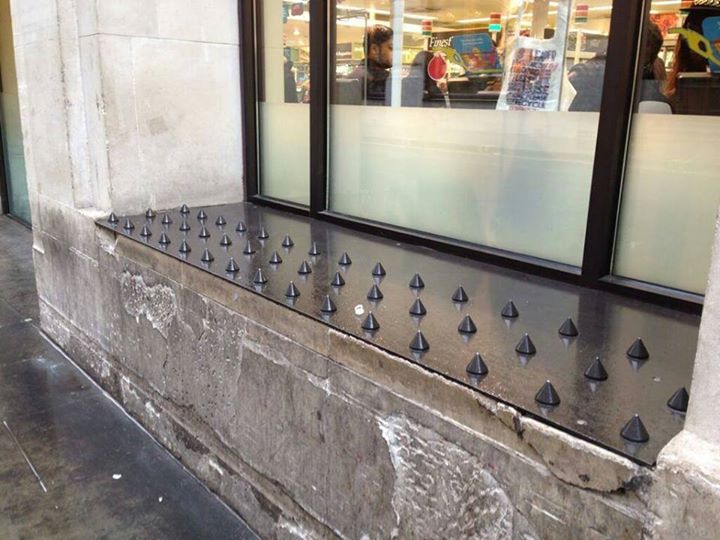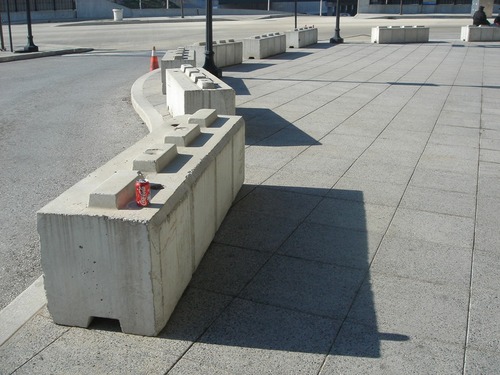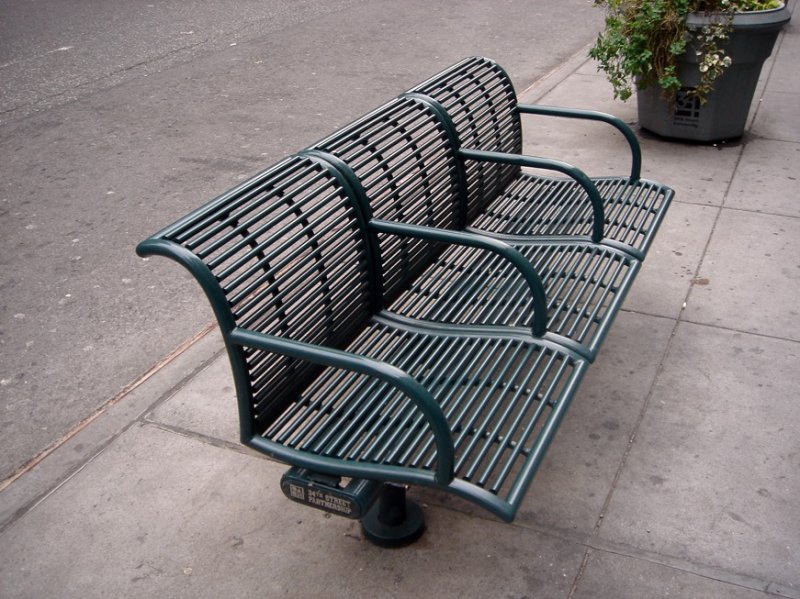Hostile architecture
Hostile architecture, also known as defensive architecture, is an area of urban design that involves the modification of buildings and public spaces to deter certain activities.
A common application of hostile architecture is in relation to rough sleeping. Techniques used to discourage this include the use of ‘anti-homeless spikes’ - steel or concrete studs embedded in flat surfaces.
Other features that can be used include:
- Railings and other forms of enclosure
- Sloping surfaces.
- Embedded stones.
- Bollards.
- Large round rocks.
- Protrusions on window ledges.
- Wave-shaped benches with central armrests to prevent people lying down
- Using uncomfortable stainless steel furniture.
- Sloping seats at bus stops.
Another activity that is often the target of hostile architecture is skateboarding. San Francisco, the city which gave rise to street skateboarding, was the first to introduce ‘pig’s ears’ – metal flanges bolted onto the corner edges of pavements and low walls to act as a deterrence.
Loitering can also be deterred, with a variety of techniques trialled around the world. In Shandong, China, a pay-per-minute system was introduced for use of its park benches. A series of studs would emerge suddenly from the seat when the occupant’s ‘paid-for’ time had elapsed. In Japan, sloped benches prevent people from leaning back, as well as tubular benches that are either too hot in summer or too cold in winter. New York has adopted a range of spiky anti-sit devices which are found on all manner of surfaces, from air-conditioning units, to fire hydrants and standpipes.
A technique that has been used by some local authorities and businesses to deter teenagers loitering is the Mosquito Alarm which emits a high-pitched sound that is inaudible to older people. A similar use of annoying local sounds can be used to prevent people standing in doorways or near the entrances to buildings.
Lighting can also be used to deter teenage loitering. Mansfield, Nottingham, installed neon pink lights in underpasses because of the way in which they highlight acne. Similarly, Tokyo has used blue lighting in some railway stations to try and alleviate the high suicide rate, blue being used for its soothing qualities.
Unsurprisingly, hostile architecture is controversial. Critics argue that it replaces public spaces with commercial or ‘pseudo-public’ spaces where contrarianism, or deviation from social conventions, is not allowed. Others argue that its use enforces and exacerbates already present social divisions.
According to the journalist Alex Andreou; ‘These measures do not and cannot distinguish the "vagrant" posterior from others considered more deserving. By making the city less accepting of the human frame, we make it less welcoming to all humans. By making our environment more hostile, we become more hostile within it.’
[edit] Related articles on Designing Buildings
- Barrier.
- Bench.
- Bollard.
- CCTV.
- Crime Prevention Design Advisor.
- Defensible space.
- Deterrent paving.
- Entry control.
- Eyesore.
- Fence.
- Outbuildings security.
- Palisade.
- Panopticon.
- Perimeter security.
- Railing.
- Ram raid.
- Secured by design.
- Security and the built environment.
- Talus.
- Street furniture.
- Urban design.
Featured articles and news
A change to adoptive architecture
Effects of global weather warming on architectural detailing, material choice and human interaction.
How big is the problem and what can we do to mitigate the effects?
Overheating guidance and tools for building designers
A number of cool guides to help with the heat.
The UK's Modern Industrial Strategy: A 10 year plan
Previous consultation criticism, current key elements and general support with some persisting reservations.
Building Safety Regulator reforms
New roles, new staff and a new fast track service pave the way for a single construction regulator.
Architectural Technologist CPDs and Communications
CIAT CPD… and how you can do it!
Cooling centres and cool spaces
Managing extreme heat in cities by directing the public to places for heat stress relief and water sources.
Winter gardens: A brief history and warm variations
Extending the season with glass in different forms and terms.
Restoring Great Yarmouth's Winter Gardens
Transforming one of the least sustainable constructions imaginable.
Construction Skills Mission Board launch sector drive
Newly formed government and industry collaboration set strategy for recruiting an additional 100,000 construction workers a year.
New Architects Code comes into effect in September 2025
ARB Architects Code of Conduct and Practice available with ongoing consultation regarding guidance.
Welsh Skills Body (Medr) launches ambitious plan
The new skills body brings together funding and regulation of tertiary education and research for the devolved nation.
Paul Gandy FCIOB announced as next CIOB President
Former Tilbury Douglas CEO takes helm.
UK Infrastructure: A 10 Year Strategy. In brief with reactions
With the National Infrastructure and Service Transformation Authority (NISTA).
Ebenezer Howard: inventor of the garden city. Book review.
Airtightness Topic Guide BSRIA TG 27/2025
Explaining the basics of airtightness, what it is, why it's important, when it's required and how it's carried out.
























